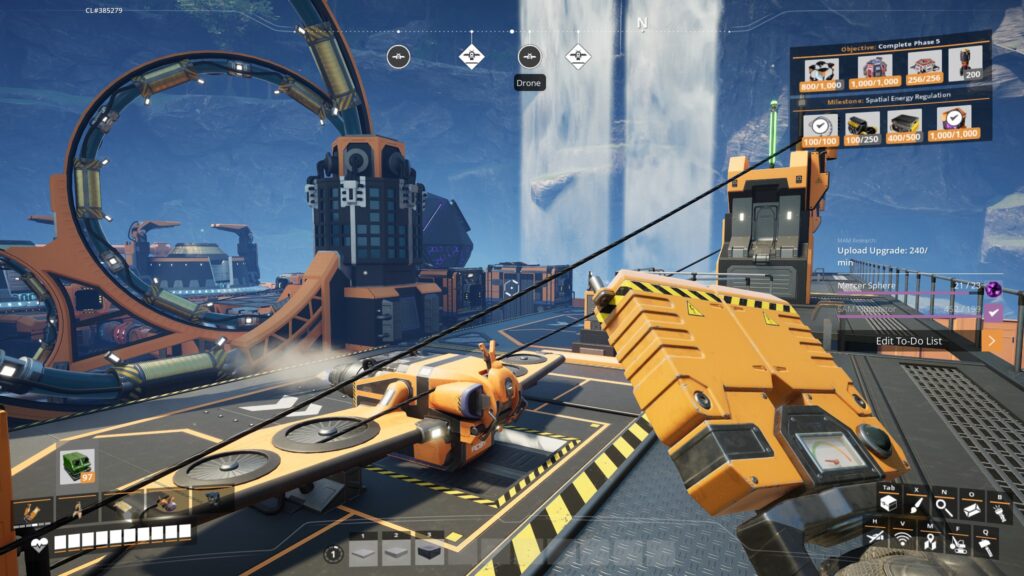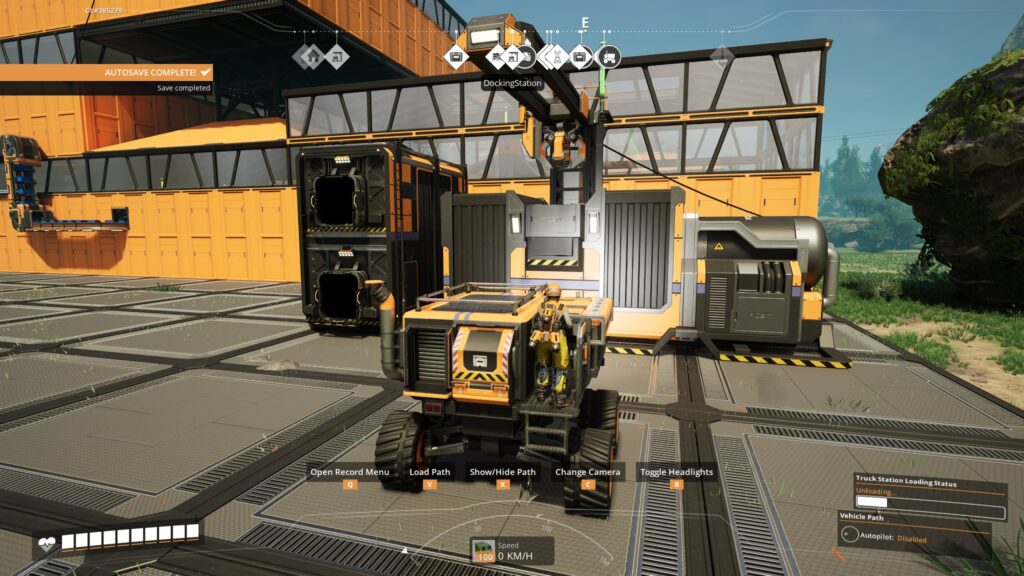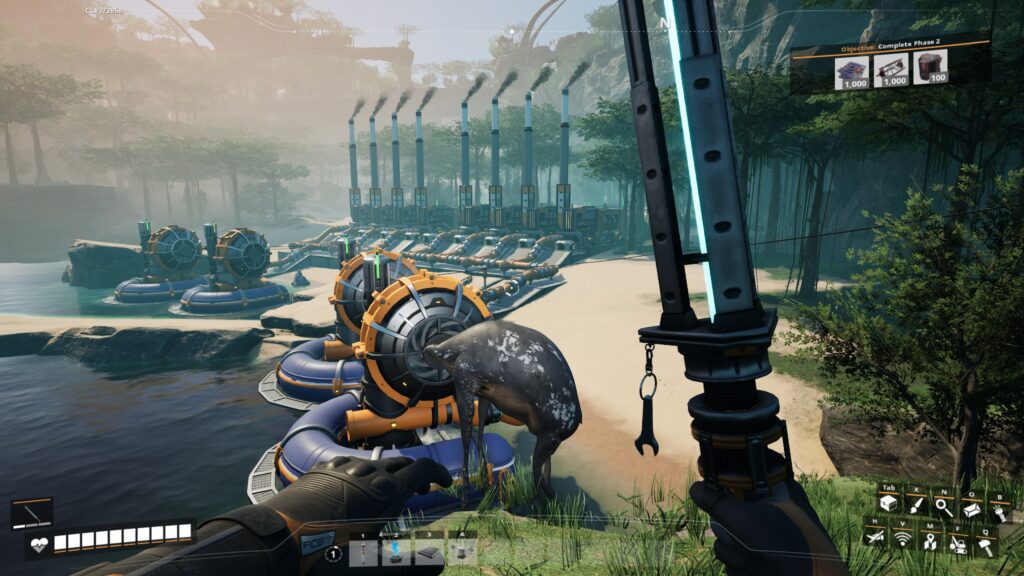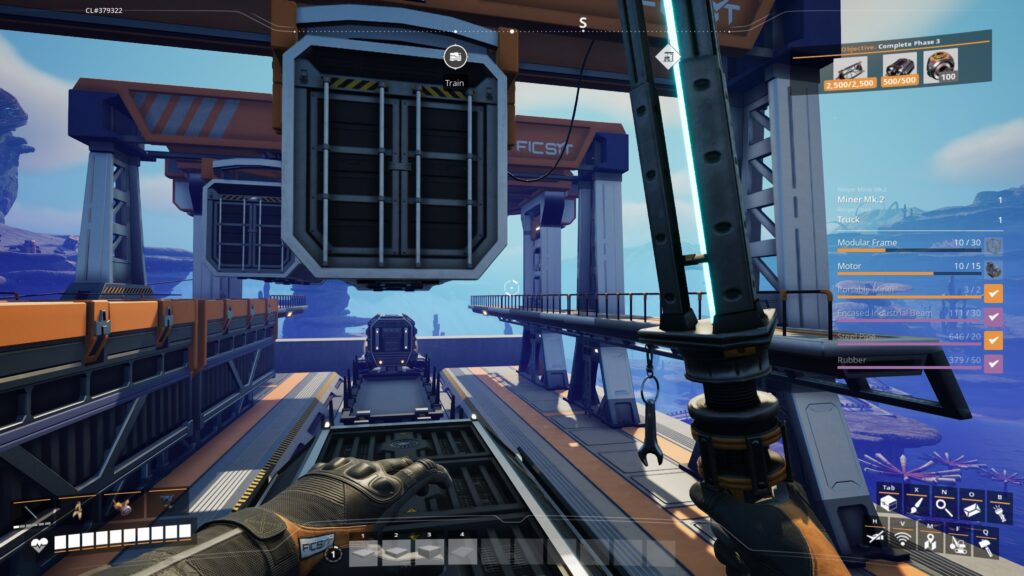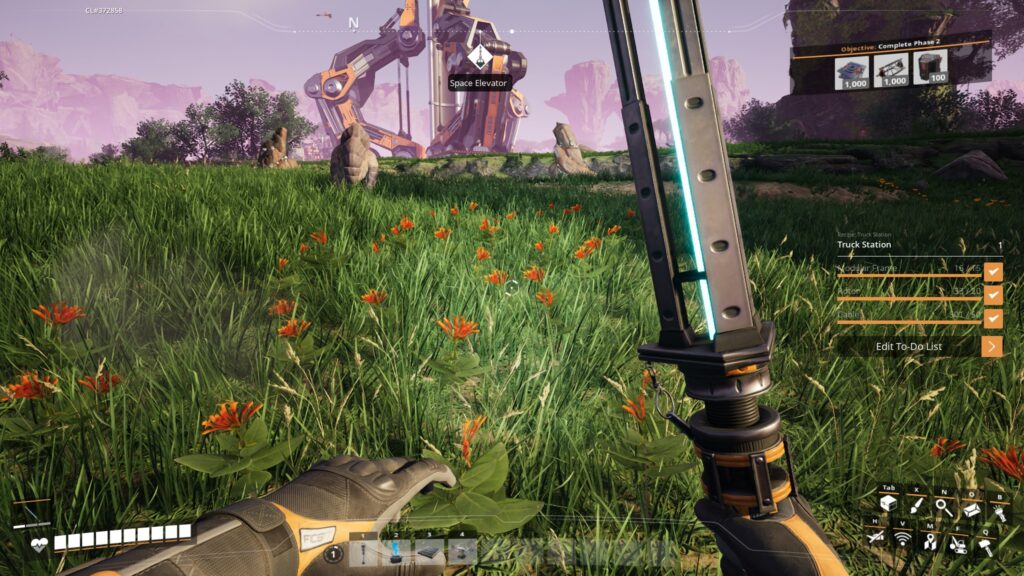I’d skipped any posts about games for the past few months because I’ve been totally engrossed in this one and it took way longer than I’d expected to complete. I’ve since clocked up almost as many hours at this as Dirt Rally 2.0 and that’s a game I’ve been playing on and off for years! I’m kind of ashamed that it took me so long really as I kept doing things by hand for way too long and procrastinated over building large-scale infrastructure which would have saved me time over the long run. Still, this is very much the kind of game that everyone plays in their own way and by and large, I’m fairly happy with what I managed to build.
The premise that you’re a pioneer dropped onto an alien planet with little idea of what is going on. Under the guidance of an AI named Ada, you set out to explore this world and exploit its resources. Your landing pod disassembles into the Hub which serves as a basic base for your operations. From there you gather resources and use them to upgrade the Hub and construct new facilities. You’ll need to supply power for everything you build and at the very beginning your only recourse is to gather up leaves and bushes by hand to feed a biomass burner. But you’ll soon be able to build coal generators that run autonomously. The ultimate objective is to construct a space elevator and supply the parts to Project Assembly orbiting the planet. As you might expect, the parts become progressively more complex requiring you to gather raw resources far from your starting area and many processing steps. This naturally leads to building vast logistical networks to connect your many factories and resource gathering facilities together. At the same time, you’ll need to contend with the hostile wildlife of the planet and possibly discover the secrets of an alien civilization on it.
This game has been in Early Access for quite a while but only got its 1.0 release not long ago. This means that the developers have had plenty of time to iron out the bugs, polish the game and get the balance just right. While you have several different starting positions to choose from, there is only just the one handcrafted world so you’ll eventually get to see it all if you want. The world isn’t really that large, objectively speaking once you see how all of the biomes connect together, but it sure feels that way at the beginning. The graphics look amazing especially once the dynamic lighting system is enabled with the day/night cycle. One would not expect it out of a building game but in between the varied biomes, lighting effects and the sheer scale of the world, it’s such an extraordinarily immersive game that many players enjoy simply looking at the scenery. Over time, you’ll also appreciate how much thought went into this handcrafted world. Resources are placed in ways that create interesting problems to solve. Enemies are sprung on you at carefully chosen points to strike maximum fear and the hunt for collectibles will lead you deep into underground caves and to the top of fantastic peaks.
At the beginning, making things is no different from crafting in any other game. You collect the needed resources, ores for example, and head back to the Hub to create whatever you need. But soon enough you’ll realize that the numbers needed are far too large to feasibly make by hand. So you need to automate the process. So you build an extractor at the node to mine iron, build a smelter to turn the raw ore into ingots, build a constructor to turn the ingots to iron plates or whatever, and link them all up with conveyor belts. You’ll also need to make sure that all of the buildings are powered and the produced items are sent into storage. You need to get the ratios of the different machines right paying attention to the numbers each take in as input and send out as output. This still isn’t too hard but eventually you need to build machines that take in multiple types of input, you need many rows of them to achieve a passable production and you need to source raw resources from a wider area in order to be able to feed all these machines.
The game does have combat in that much of the wildlife is hostile and will attack whenever you’re too near. Some are quite intimidating, especially the giant spiders which can jump far higher than anyone expects. As you advance up the tech tree, you naturally unlock more powerful weapons to deal with them. The terrain also presents a challenge to exploring the world as some cliffs and structures appear to be insurmountably tall. But never forget that this is indeed a building game. If you need to go somewhere, you can always build a bridge or stairs to get there. You can even build a tower from which to safely snipe at enemies or even a box to trap them inside. There’s a fair variety of enemy types but I eventually found myself annoyed by how often they respawn and so turned their aggressiveness off. Once you have access to more powerful weapons and mobility options, it’s not particularly difficult to kill the enemies but it’s still time consuming to have to repeatedly do it and it’s really not the point of the game.
Completing the game entails the player delivering all of the parts needed for Project Assembly. It’s a daunting endeavor but a perfectly achievable one with the tools the game gives you. As many other players have realized, the real obstacles are your own sense of aesthetics and the limits you impose on yourself. The game doesn’t care about ugly factories and conveyor belts snaking all over the place, but maybe you do. Similarly the game doesn’t enforce gravity on your construction. Want to build a massive platform in the air that supports all of your factories? Go for it. Extend a conveyor lift all the way up to the top of a mountain? It’s all good, man. Many players however dislike implausible floating structures and so at least try to build proper supports for them even if they’re not needed. Many also build walls and roofs to create proper buildings and add decorative details to them. That’s where the game is a real time sink. Once you get started on prettifying your builds, and there’s no end to it and you’ll quickly rack up the hours but it sure is fun and satisfying for a lot of people. Others might become obsessed with achieving perfect efficiency, trying to maximize the output from each resource node and making sure that the machines are always fully supplied. The alternative recipes you can unlock from collecting hard drives can be much more efficient than the standard ones. But it is so much work to tear down old factories to remake them to take advantage of the new recipes.
One major complaint that I have is that the gameplay is very awkward and unwieldy at the beginning. You effectively run around as a human-scale person laying down factories that are many times larger than you. Often the factory can’t even fit into your field of view so how are you supposed to align it properly or know if it’ll even fit in a certain space? You also move very slowly across the world and can’t jump very high either. For me the game doesn’t really come alive until you unlock the personal equipment that improves your mobility and lets you fly and hover. Once you’re able to freely fly, it’s much easier to look down at your factories and place them exactly where you want. Another problem is that the game invites you to play the part of an architect and build massive structures but there are just too few parts available. Some players have managed to construct some truly amazing stuff but they did it by tediously clipping many parts together to create new shapes. Others use mods to place the parts in ways that are impossible in the base game.
The game is still being updated so hopefully a better variety of parts will be coming. Rumor has it that a straight-mode is going to be added, which would make it easier to lay down straight, aesthetically pleasing pipelines. That would be a huge plus. That said I’m likely done with the game unless they release a major DLC or something. This already took up so much of my time and my backlog of unplayed games keeps growing. I’ve always suspected that I would quickly become engrossed in construction games of this type. This was my first real one and I was right. It’s scary how obsessed I became with this for a while, even dithering with spreadsheets to plan out my builds and poring over the map to identify the best location for a factory. There’s no question that this was one of the greatest gaming experiences I’ve had. I probably will pick up another game in this genre because I do enjoy it. But not for a very long while because I need to play other stuff as well.
